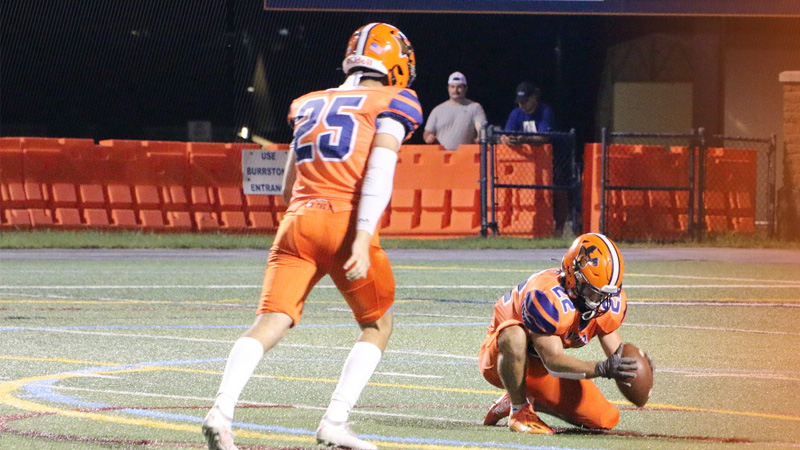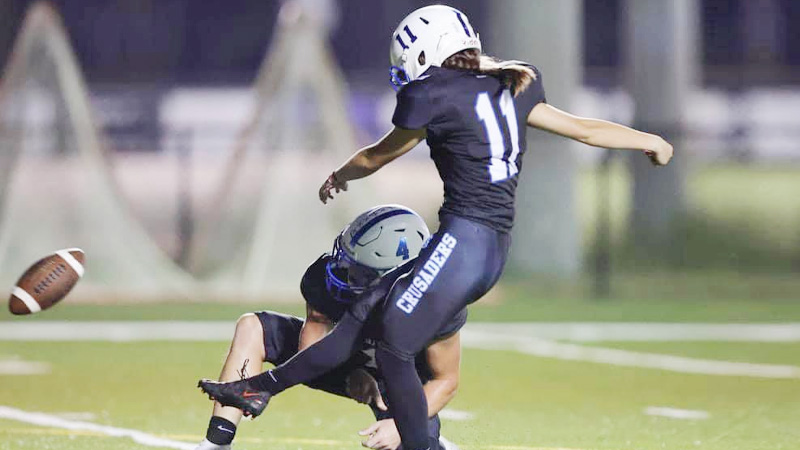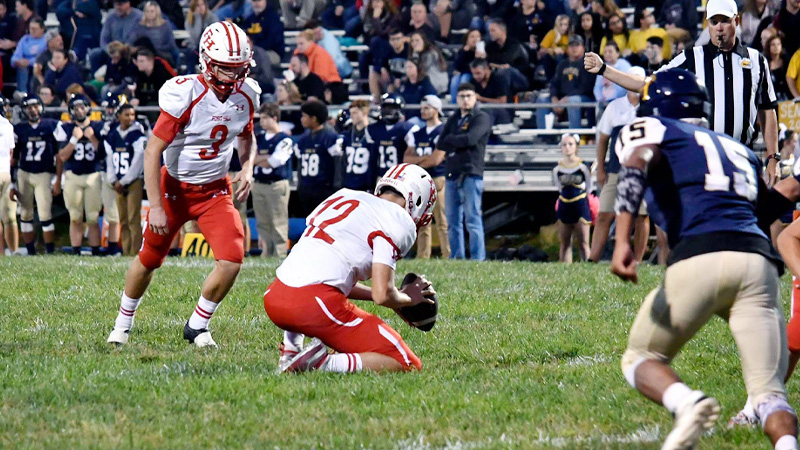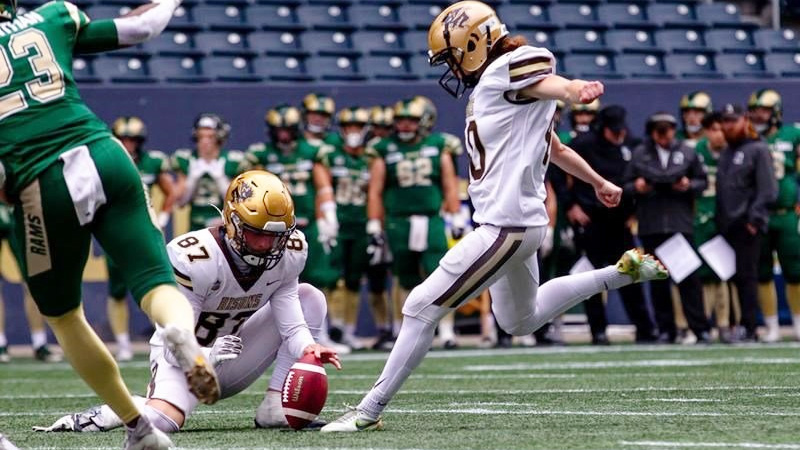High school football is not only a breeding ground for talent but also a place where extraordinary moments etch themselves into the annals of the sport. Among these moments, the quest for the longest field goal holds a special place.
It’s a testament to the raw talent and dedication of young athletes, the culmination of coaching and practice, and the enduring spirit of competition.
One such legendary moment occurred on September 27, 1985, during a clash between Reno High School and Sparks High School in Nevada.
It was on this historic day that Dirk Borgognone stepped onto the field and, with a powerful leg, sent a football soaring through the uprights from an astounding 68 yards away.
But this record-setting feat is just one of the many incredible stories that make high school football a breeding ground for remarkable achievements.
In this blog post, we delve into the awe-inspiring world of high school football’s longest field goals and the impact they’ve had on the game and its young athletes.
What Is Field Goal Kicked In High School Football?
In high school football, a field goal is a method of scoring points by kicking the football through the opponent’s goalposts. Here are some key points about field goals in high school football:
Scoring
A successful field goal is worth three points on the scoreboard. It is one of the ways for a team to accumulate points during a game.
Kicking Distance
High school football field goals are typically attempted from much shorter distances than in professional or college football.
The exact distance can vary depending on the skill of the kicker, weather conditions, and other factors, but it is usually around 30 to 40 yards or even shorter.
Placement
Before attempting a field goal, the offense must position the ball on the field in a location where the kicker has a good angle and distance to kick the ball through the goalposts.
This is usually done by the holder, who places the ball on the ground or holds it in place for the kicker.
Snap and Hold
Similar to the NFL and college football, high school football teams have a long snapper who snaps the ball to the holder for the field goal attempt.
The holder’s job is to catch the snap and place the ball for the kicker.
Kicking Technique
The kicker uses a specialized technique to kick the ball accurately and with enough force to clear the goalposts.
This involves a run-up and a swinging motion of the leg, striking the ball with the top part of the foot.
Goalposts
High school football goalposts are typically narrower than those in college and professional football. The width between the uprights is usually 23 feet and 4 inches, which is slightly less than the 18.5-foot width in the NFL.
Missed Field Goals
If a field goal attempt is missed (the ball does not go through the goalposts), the opposing team takes possession of the ball at the spot where the kick was attempted, typically at the line of scrimmage or the point where the ball was held.
Field goals can play a crucial role in high school football games, especially in situations where a team is within kicking range and wants to add points to their score or break a tie.
Skilled kickers are valuable assets to high school football teams for this reason.
What Is The Longest Field Goal Kicked In High School Football?

the longest field goal ever kicked in a high school football game was indeed a remarkable feat accomplished by Dirk Borgognone on September 27, 1985.
This impressive kick took place during a game between Reno High School and Sparks High School in Nevada.
Here’s an elaborate look at this historic moment:
The Kicker
Dirk Borgognone was the talented kicker who achieved this extraordinary feat.
High school football teams often rely on the skills of their kickers to score field goals and extra points, making Borgognone a valuable asset to his team.
The Game
The record-breaking field goal occurred during a regular high school football game, which added to the significance of the achievement.
High school football games are typically competitive events with enthusiastic crowds, and moments like this can become legendary in the local sports community.
The Distance
The field goal attempt by Dirk Borgognone was an astonishing 68 yards in length.
To put this into perspective, in professional football, field goals of this distance are exceedingly rare, and kickers who can consistently make kicks from such a distance are considered elite in the sport.
Field Conditions
The condition of the field and weather can greatly impact a field goal attempt.
High school football games can be played in various weather conditions, and Borgognone’s successful kick might have been influenced by favorable conditions or a strong tailwind that helped the ball travel such a long distance.
Kicking Technique
Achieving a 68-yard field goal requires a combination of power, precision, and proper kicking technique.
The kicker needs to generate significant leg strength to send the ball over the goalposts, and the technique must ensure accuracy in both the direction and height of the kick.
Historical Significance
Borgognone’s record-setting field goal gained recognition not only at the local level but also nationally.
High school football records, especially when they involve such remarkable feats, often become part of the sport’s history.
Impact on the Game
This field goal significantly impacted the game’s outcome.
Scoring 3 points from such a long distance would have been a morale boost for Borgognone’s team, and it could have influenced the strategies employed by both teams for the rest of the game.
Nonetheless, Dirk Borgognone’s 68-yard field goal in 1985 remains a remarkable and memorable moment in the history of high school football.
Key Components of a Successful Field Goal

A successful field goal in American football, whether at the high school, college, or professional level, involves several key components:
Snap
The play begins with a snap from the long snapper to the holder. The snap must be accurate and on target to ensure a smooth execution of the kick.
Hold
The holder is responsible for catching the snap and placing the football in the optimal position for the kicker. The hold must be stable and properly oriented, allowing the kicker to make clean contact with the ball.
Kicker
The kicker is the player responsible for striking the football with their foot. Key aspects of the kicker’s role in a successful field goal include:
Technique
The kicker must have a consistent and effective kicking technique. This involves the approach to the ball, the angle of contact, and the follow-through.
Power
Kicking the football with enough power to clear the crossbar and go through the uprights is crucial, especially for longer field goals.
Accuracy
The kicker needs to be accurate in aiming for the center of the uprights. Even a small deviation in direction can result in a missed field goal.
Protection
The offensive line and special teams players must provide protection to prevent the opposing team from blocking the kick. This involves blocking defenders who are attempting to rush in and block the field goal.
Goalposts
The goalposts consist of two uprights and a horizontal crossbar. The objective of the kicker is to send the football through the uprights and above the crossbar.
Distance and Angle
The distance from the line of scrimmage to the goalposts and the angle from which the kick is attempted are crucial factors. Kickers must adjust their power and aim based on these variables.
Wind and Weather Conditions
Environmental factors, such as wind direction and speed, can significantly impact the flight of the football. Kickers and holders often take these conditions into account when lining up for a field goal.
Timing
The timing between the snap, hold, and kick must be precise. Any disruption in this timing can lead to a missed field goal.
Mental Focus
Kicking a field goal requires mental toughness. Kickers must remain composed and focused, especially in high-pressure situations such as critical moments in a game.
Coaching and Practice
Successful field goal attempts are the result of extensive practice, coaching, and repetition. Kickers work on their technique, timing, and accuracy through regular practice sessions.
Team Chemistry
Good communication and chemistry between the long snapper, holder, and kicker are essential. Trust and familiarity between these players contribute to successful field goals.
Game Situation
Understanding the game situation is crucial. Coaches and players need to decide when to attempt a field goal based on the score, time remaining, and field position.
The decision to attempt a field goal should take these factors into account.
A successful field goal in football involves a combination of technical skill, teamwork, physical ability, and mental focus.
Each of these components must come together seamlessly to execute a successful kick and earn points for the team.
The Impact of Field Goals Beyond the Field

Field goals in football have an impact that extends beyond the field of play. They can influence various aspects of the game, the team, and even the broader community.
Here are several ways in which field goals can have an impact beyond the field:
Game Outcome
Field goals can be the deciding factor in the outcome of a football game. They provide a means for a team to accumulate points when they are unable to score touchdowns.
A successful field goal can secure a win, break a tie, or narrow a deficit, affecting the standings and playoff implications.
Strategy and Play Calling
Coaches must factor in their kicker’s abilities when making strategic decisions. Knowing the range and accuracy of their kicker can influence decisions on when to attempt a field goal, go for it on fourth down, or punt the ball.
The threat of a reliable kicker can also impact opposing defenses’ strategies.
Momentum and Morale
A successful field goal can shift the momentum of a game. It can energize the team that made the kick and demoralize the opponent.
Conversely, a missed field goal can have the opposite effect, affecting players’ confidence and determination.
Pressure Situations
Field goals often come into play in high-pressure situations, such as late-game scenarios where a team needs to score quickly to win or tie.
The ability of a kicker to handle pressure can become a defining characteristic of their career.
Player Development
Kickers in high school, college, and professional football have dedicated coaches and trainers who help develop their skills.
These individuals often play a critical role in the development of young athletes, both on and off the field.
Scholarships and Recruitment
Exceptional high school kickers who consistently make field goals and perform well in games can attract the attention of college recruiters.
Successful field goal kickers may earn scholarships to further their education while playing football at the collegiate level.
Fan Engagement
Memorable field goals become iconic moments in football history. Fans often remember and celebrate long or game-winning field goals for years. These moments contribute to fan engagement and the lore of the sport.
Community Pride
Successful field goals can bring a sense of pride to a community.
High school and college football teams often have strong ties to their local communities, and victories, including those secured by field goals, can unite fans and boost community spirit.
Record-Breaking Achievements
Record-breaking field goals, like the example mentioned earlier of Dirk Borgognone’s 68-yard field goal in high school, become part of the sport’s history.
They are celebrated as historic achievements and inspire future generations of kickers.
Life Skills
Kicking specialists develop discipline, dedication, and resilience through their training and experiences. These life skills can extend beyond the football field and positively influence their personal and professional lives.
Field goals in football are not just about scoring points on the field; they have wide-ranging effects on the game, the team, and the broader sports community.
They can shape strategies, impact morale, and create memorable moments that resonate with fans and players alike.
Challenges and Opportunities Regarding Field Goals
Field goals in football present both challenges and opportunities for teams and players. These challenges and opportunities can have a significant impact on the game and the individuals involved.
Here are some of the key challenges and opportunities associated with field goals:
Challenges
- Pressure and Mental Toughness: Kicking field goals, especially in critical game situations, can be mentally taxing. Kickers must deal with pressure and maintain their composure to perform effectively.
- Distance and Accuracy: Hitting longer field goals requires both power and precision. Overcoming the physical challenge of kicking the ball accurately over longer distances can be demanding.
- Weather Conditions: Weather, including wind, rain, and extreme temperatures, can affect the flight of the football, making field goal attempts more challenging.
- Blocking Attempts: Defensive players often try to block field goal attempts, and kickers must be aware of these attempts and adapt their technique to avoid blocks.
- Injury Risk: Kickers are exposed to injury risks, especially if a defender makes contact with them during or after a kick. This adds a level of physical challenge to their role.
- Limited Scoring: Field goals are worth fewer points (typically three) than touchdowns (six) or two-point conversions (two). Teams may face challenges in scoring enough field goals to keep pace with opponents who score touchdowns.
Opportunities
- Scoring Points: Field goals provide a reliable way to score points, even when a touchdown is not achievable. Successful field goals can add to a team’s overall score and contribute to winning games.
- Game-Changing Moments: Field goals can be game-changers, especially when they come in clutch situations, like last-minute game-winners or long-distance kicks that shift momentum.
- Specialized Role: Kicking specialists, including field goal kickers, have specialized roles on football teams. This specialization creates opportunities for individuals to excel in a specific aspect of the game.
- Recruitment and Scholarships: Exceptional high school kickers may earn scholarships to play college football. This provides opportunities for education and the chance to continue their football careers at a higher level.
- Legacy and Recognition: Successful kickers who make memorable field goals can leave a lasting legacy in the sport. Their achievements are celebrated and remembered by fans and the football community.
- Improvement Through Practice: Field goal kickers have the opportunity to improve their skills through dedicated practice and coaching. Continuous improvement can lead to greater success on the field.
- Team Strategy: Field goal kickers can influence team strategy, helping coaches make informed decisions about when to attempt a field goal, go for it on fourth down, or punt the ball.
- Community and Fan Support: Successful field goals can generate excitement and support from fans and the local community. Memorable field goals are often replayed and discussed, contributing to the team’s fanbase.
Field goals present challenges related to mental toughness, physical skills, and scoring limitations.
However, they also offer opportunities for players to make significant contributions, earn scholarships, and become celebrated figures in the sport.
Field goals are an integral part of football, and how teams and individuals approach them can shape the outcome of games and impact the legacy of players.
FAQs
What is the longest field goal ever kicked in high school football?
The longest field goal ever kicked in high school football was a 68-yard kick by Dirk Borgognone on September 27, 1985, during a game between Reno High School and Sparks High School in Nevada.
Has anyone broken Dirk Borgognone’s record for the longest high school field goal?
Dirk Borgognone’s record of a 68-yard field goal still stands as the longest in high school football. New records may have been set since then, but I don’t have that information.
Who holds the record for the longest field goal in college football?
As of my last knowledge update in September 2021, the longest field goal in college football history was a 69-yard kick by Ove Johansson of Abilene Christian University in 1976.
Please verify if this record still holds, as records can change over time.
What factors contribute to a kicker’s ability to kick a long field goal in high school football?
A kicker’s ability to kick a long field goal depends on factors like leg strength, kicking technique, weather conditions, and field conditions.
Proper training, practice, and favorable circumstances play a significant role in achieving longer kicks.
Do high school kickers receive recognition or scholarships for their field goal achievements?
Yes, high school kickers who demonstrate exceptional talent and consistency in making field goals may receive recognition from their teams, schools, and even college recruiters.
Outstanding performance in high school football, including successful field goals, can lead to scholarship opportunities for college education.
Wrapping Up
High school football, with its moments of gridiron glory, showcases the resilience and talent of young athletes.
Records like Dirk Borgognone’s 68-yard field goal serve as testaments to the potential that lies within the halls of high schools across the nation.
They inspire new generations of kickers, unite communities, and leave indelible marks on the sport’s history.
As the pursuit of the longest field goal in high school football continues, so does the legacy of those who dare to kick for the stars.
These moments are a reminder that the spirit of competition and the pursuit of excellence is alive and well on the high school gridiron, where legends are born.







